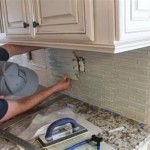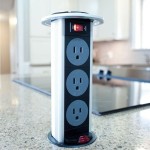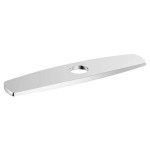```html
Undermount Kitchen Sink: The Single Bowl Solution
The kitchen sink is a critical element in any functional kitchen space. Selecting the right type of sink requires consideration of several factors, including material, size, configuration, and installation method. The undermount kitchen sink, particularly the single-bowl variation, has gained significant popularity for its clean aesthetics and practical advantages. This article aims to provide a comprehensive overview of undermount kitchen sinks with a single bowl, exploring their features, benefits, installation considerations, and factors to consider when making a purchase.
Unlike drop-in or top-mount sinks, an undermount sink is installed beneath the countertop. This means the sink rim is attached to the underside of the countertop, creating a seamless transition between the countertop surface and the sink basin. This installation method offers a number of visual and functional benefits compared to traditional sink styles. The single-bowl configuration, in particular, provides a large, unobstructed space for washing dishes and handling large pots and pans.
Aesthetic Appeal and Ease of Cleaning
One of the primary reasons homeowners choose undermount single-bowl sinks is their clean and modern aesthetic. The absence of a visible rim around the sink allows for a more streamlined look, integrating the sink seamlessly into the overall countertop design. This is especially appealing when paired with high-quality countertop materials like granite, quartz, or solid surface. The absence of a lip also prevents the accumulation of dirt and grime, making it easier to wipe down the countertop directly into the sink. This is a significant advantage over top-mount sinks, where debris can become trapped under the rim.
The smooth transition between the countertop and the sink basin contributes to a more hygienic kitchen environment. With no crevices or ledges, there are fewer places for bacteria and mold to grow. This facilitates easier and more thorough cleaning, minimizing the risk of contamination. The single-bowl design further simplifies cleaning, as there are no dividers or corners to navigate, allowing for quick and efficient maintenance.
Furthermore, the undermount installation allows for a greater expanse of usable countertop space. The uninterrupted surface provides more room for food preparation and other kitchen tasks. This is particularly beneficial in smaller kitchens where every inch of counter space is valuable. The clean lines and uncluttered surface contribute to a more spacious and organized feel.
Advantages of a Single Bowl
The single-bowl configuration provides a large, uninterrupted basin, making it ideal for washing oversized items like baking sheets, large pots, and pans. This is a significant advantage over sinks with multiple bowls, which can restrict the size of items that can be easily accommodated. The single-bowl design allows for greater flexibility in handling various kitchen tasks.
While some may argue that a double-bowl sink is more efficient for separating clean and dirty dishes, a single-bowl sink can be equally effective with proper organization. Using a dish rack within the sink or alongside it can provide a designated space for drying dishes. Alternatively, a separate drying mat can be used to absorb excess water. The key is to establish a system that works efficiently for individual needs and preferences.
The single-bowl design also offers greater versatility in terms of faucet placement. With no divider obstructing the space, the faucet can be positioned anywhere along the back of the sink, allowing for optimal reach and functionality. This flexibility is particularly useful for accommodating various faucet styles, including those with pull-down or pull-out sprayers.
Moreover, single-bowl sinks are often more affordable than double-bowl sinks of comparable quality and material. The simpler design and manufacturing process can translate to lower costs for both the sink itself and the installation process.
Material Selection and Durability
Undermount single-bowl sinks are available in a variety of materials, each with its own unique characteristics and benefits. Stainless steel is a popular choice due to its durability, resistance to corrosion, and affordability. Stainless steel sinks are also relatively easy to clean and maintain, making them a practical option for busy kitchens.
The gauge of the stainless steel refers to its thickness. A lower gauge number indicates a thicker and more durable material. For kitchen sinks, a gauge of 16-18 is generally recommended for optimal performance and resistance to dents and scratches. A higher gauge number may be more susceptible to damage over time.
Composite granite sinks are another popular option, offering a combination of durability and aesthetic appeal. These sinks are made from a mixture of granite stone dust and acrylic resins, creating a non-porous surface that is resistant to scratches, stains, and heat. Composite granite sinks are also available in a wide range of colors and finishes, allowing for greater design flexibility.
Fireclay sinks are known for their classic and elegant look. These sinks are made from clay that is fired at extremely high temperatures, resulting in a durable and non-porous surface. Fireclay sinks are resistant to scratches, stains, and chips, making them a long-lasting option. However, they can be more expensive than stainless steel or composite granite sinks.
Cast iron sinks with an enamel coating offer a traditional and durable option. The cast iron provides strength and stability, while the enamel coating provides a smooth and non-porous surface. These sinks are resistant to scratches, stains, and heat, but they can be heavy and require specialized installation techniques.
The choice of material will ultimately depend on individual preferences, budget, and the overall design of the kitchen. It is important to consider the long-term durability and maintenance requirements of each material before making a decision.
Installation Considerations and Countertop Compatibility
Installing an undermount sink requires careful planning and precise execution. Since the sink is mounted beneath the countertop, the countertop material must be strong enough to support the weight of the sink and any water or dishes it contains. Solid surface materials like granite, quartz, and solid surface are ideal for undermount sink installations due to their strength and durability.
Laminate countertops can also be used with undermount sinks, but they require extra reinforcement to prevent sagging or water damage. The edges of the countertop must be properly sealed to prevent moisture from penetrating the core material. It is generally recommended to consult with a professional installer to ensure proper installation and prevent potential problems.
The installation process typically involves cutting a precise opening in the countertop to match the dimensions of the sink. The sink is then attached to the underside of the countertop using clips, adhesive, or a combination of both. The plumbing connections are then made to the faucet and drain.
Proper sealing is crucial to prevent water leaks and damage to the countertop and surrounding cabinetry. A high-quality silicone sealant should be applied around the perimeter of the sink to create a watertight seal. It is important to follow the manufacturer's instructions carefully and allow the sealant to cure completely before using the sink.
Professional installation is highly recommended for undermount sinks, as it requires specialized tools and expertise. A qualified installer can ensure that the sink is properly installed and sealed, preventing potential problems and ensuring long-term performance.
Size and Depth Considerations
The size and depth of the single-bowl undermount sink should be carefully considered based on individual needs and the available space in the kitchen. A larger sink can accommodate larger items, but it may also take up more countertop space. A deeper sink can prevent splashing and provide more room for washing dishes, but it may also require more bending and straining.
The standard depth for a kitchen sink is typically between 8 and 10 inches. However, deeper sinks are available for those who prefer more vertical space. It is important to consider the height of the user and the potential for strain when selecting a sink depth.
The width and length of the sink should be proportionate to the countertop space and the size of the kitchen. A smaller kitchen may benefit from a compact sink, while a larger kitchen can accommodate a larger sink without feeling cramped.
It is also important to consider the placement of the sink in relation to other kitchen elements, such as the dishwasher and the cooking area. The sink should be positioned in a location that allows for efficient workflow and easy access to other kitchen appliances.
Factors to Consider Before Purchasing
Before purchasing an undermount single-bowl sink, several factors should be carefully considered to ensure that the chosen sink meets individual needs and preferences. The material, size, depth, and installation requirements should all be taken into account.
The budget is also an important consideration. Undermount sinks can range in price from a few hundred dollars to several thousand dollars, depending on the material, size, and features. It is important to set a budget and stick to it when shopping for a sink.
The warranty is another important factor to consider. A good warranty can provide peace of mind and protection against defects in materials or workmanship. It is important to read the warranty carefully and understand the terms and conditions before making a purchase.
Finally, it is important to read reviews and compare different models before making a decision. Customer reviews can provide valuable insights into the performance and reliability of different sinks. Comparing different models can help identify the best option for individual needs and preferences.
```
Kraus Khu100 32 Inch 16 Gauge Undermount Single Bowl Stainless Steel Kitchen Sink

Karran Undermount 32 25 In X 19 White Quartz Single Bowl Kitchen Sink Qu 812 Wh At Lowes Com

Delta Everest 32in Granite Composite Workstation Kitchen Sink Undermount Single Bowl With Workflow Ledge And Accessories

16 Gauge Undermount Stainless Steel Single Bowl Kitchen Sink

Ruvati 35 Inch Undermount 16 Gauge Rounded Corners Large Kitchen Sink Stainless Steel Single Bowl Rvh7466 Usa

Stainless Steel 32 Inch Single Bowl Undermount Kitchen Sink By Randolph Morris Rmxk32b1 Gb Gun Metal

Empire Industries Sp19c 32 Inch Single Bowl Undermount Kitchen Sink With High Capacity Basin Soundproofing Technology And Corrosion Resistant

Karran Undermount Quartz Single Bowl Kitchen Sink White

Kraus Kore Workstation 32 Inch Drop In Or Undermount Single Bowl Stainless Steel Kitchen Sink With Accessories Pack Of 5 Walmart Com

30 Undermount 16 Gauge Stainless Steel Single Bowl Kitchen Sink Ksn








